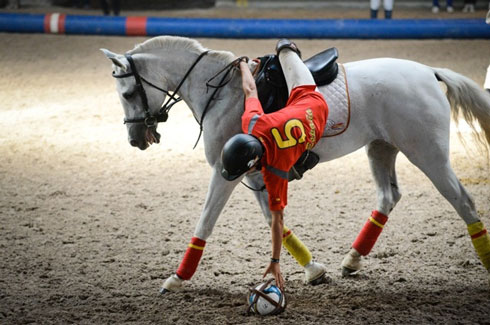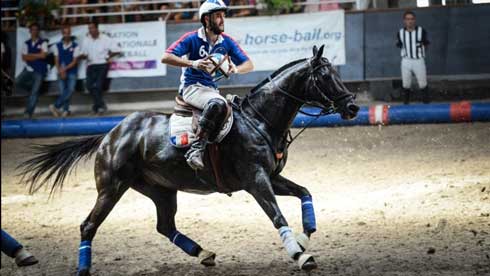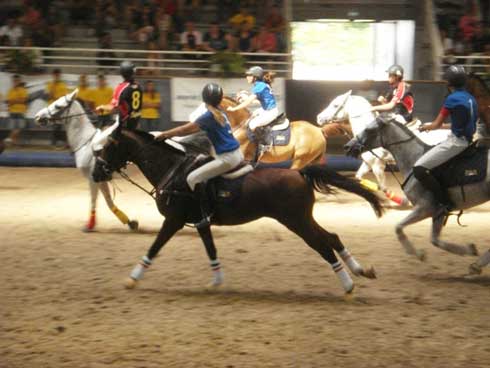Horses Have a Ball in France
By Paula Parisi August 20, 2013Like polo, larger ball, lose the stick. That’s horseball, which also shares elements of rugby and basketball. The French team has been crowned champion at the finals that took place at the multi-disciplinary Normandie Horse Show de Saint-Lô, Aug. 9-18.
Following intense competition Aug. 13-17, the French Pro Elite team, known as the Blues, held off a threat from the Spanish and won 12 to 10, notching its 19th international title.
In addition to the world title, the 2013 Horse-Ball European Championships served as a testing grounds for the 2014 World Equestrian Games in Normandie, where horseball will be featured as a demonstration event.
In addition to winning the highest level, France’s juniors (under 16) and women’s teams also won at the competition, which saw challengers from Portugal, Austria, Italy and Belgium vie for the trophy.
“The French women are undefeated on the international scene for 10 years, and our goal is that it continues many years,” coach Raphael Dubois said following the game.
The sport of horseball originated in France in the late 1770s – created by the French Sports Federation, which wanted a fast-moving equestrian sport, suitable for telecast, that could be played in a small arena. Voilà, horseball!

Spanish player in a pose demonstrating the delicate balancing act that is horseball. (Photo courtesy Horse-Ball M3)
As in rugby, players can have body contact. Like basketball, the ball must be exchanged among teammates a minimum of three times before they can score, and no one player can hold the ball for more than 10 seconds.
Teams consist of six players, with four on the field and two in reserve. Akin to polo, they are racing around on horseback, trying to get the ball into the opponent’s goal, but at 27-yards wide by 76-yards long (25 x 70 meters) the field is much smaller than that used for outdoor polo (the size of nine American football fields). A match consists of two 10-minute halves, divided by a three-minute break.
The sport is extremely fast-moving, and involves almost gymnastic skill, as riders not only catch the ball in mid-air, but reach down from the saddle to scoop it up from the ground.
“You have to pick up the ball without dismounting,” explains Eric Bassot, first vice president of the Paris-based Fédération Internationale Horseball (FIHB). “The complicity between the horse and rider is amazing, and the game involves a lot of strategy.”
Bassot points to the organization’s website, www.fihb.net, which includes a historical list of tribal sports played on horseback. As with classical pastimes such as Pato (which originated in Argentina, where it is still played today, albeit with a ball instead of a duck!), Koug Bourou in Central Asia or Afghanistan’s Buskachy, horseball’s origins are purely recreational, rather than rooted in military exercises, like so many other horse sports.
The FIHB is working to make horseball a global sport in which riders of different ages and skill levels can participate. The FIHB lists 18 member countries, including Mexico, Brazil, China, Great Britain and Kyrgyzstan and Canada. (The U.S. is not a member.)
The French have about 4,000 riders competing annually in tournaments, with as many as 8,000 spectators filling the venues. (For more details on the sport, click here.)
The Pro Elite and Under 16‘s championships saw each team competing against all other teams, accumulating points. A win earned three points; a tie, two points; a loss, one point. For the Women’s championship every team competed during the first three days, with a semi-final taking place Aug. 16 and a grand final Aug. 17.
In the end, it was three gold for France, two silver and one bronze for Spain, one silver and one bronze for Portugal and one bronze for Belgium. Austria won the Fair Play prize, while France’s Michael Legal was named the best rider and Spain’s Gerard Garcia the top-scorer, with 16 goals.
Although horseball as yet is not sanctioned by the Federation Equestre Internationale (FEI), which regulates global competiton, the FIHB leadership hope the WEG demonstration will help bring it to prominence within the group.
Meantime, the large and appreciative crowds of spectators who come to see the games will continue to be the best ambassadors to the sport. The next important horseball competition will be the Senior Champions League match at the Vienna Horse Show in Austria, October 4-5 at the Arena Nova. The event takes place during the Apropos Pferd trade show, one of the largest exhibitions for equestrian sports, equipment and breeding, Oct. 3-10.
Below are results for the 2013 Horse-Ball European Championships:
Championship of Europe PRO ELITE
1) France – 12 points
2) Spain – 10 points
3) Portugal – 8 points
4) Belgium – 6 points
5) Austria – 4 points
(Arthur Schwob, Benjamin Deponts, Benoit Lévêque, Clement Haby, Florian Moschkowitz, Jean-Baptiste Depon, Mikel Le Gall and Nicolas Thiessard; Raphael Dubois, coach; Christophe Desormeaux, assistant)
– – – – –
Championship of Europe LADIES
1) France
2) Spain
3) Belgium
4) Portugal
(Cécile Gillon, Delphine Lebris, Gaëlle Lebris, Hélène Petitdemange, Marie Quetier, Mathilde Duboscq, Morgane Lambert, Samantha Lemaire; Raphael Dubois, coach)
– – – – –
Championship of Europe UNDER 16
1) France – 10 points
2) Portugal – 9 points
3) Spain – 9 points
4) Italy – 8 points
5) Belgium – 4 points
(Alexis George, Amanda Elvira, Basile Victor Toussaint, Laws Rigaud, Marius Doye Pierrick Jaudon, Romane Bordes, Valentine Desormeaux; Raphael Dubois, coach; Dominique Bouchery, assistant)
Short URL: https://theequestriannews.com/?p=16948




